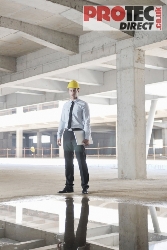Personal protective equipment, or PPE as it’s more commonly known, is designed and used in the workplace to protect staff against assessed health and safety risks. It includes some standard items, such as helmets, gloves, and safety harnesses, but can also include more specialist workwear and protective devices such as respirators, chemical shields and body protection.
PPE is a crucial part of the constant drive to make workplaces safer for those who work there. Along with the provision of PPE, which is legally required in the UK in most instances, employers are also responsible for providing the instructions, procedures, training and supervision to ensure it is used correctly.
It is also the employer’s responsibility to ensure the equipment is in good working order and solid enough condition to do its job. In many instances, this also includes the correct storage of PPE.
Storing PPE correctly is essential in making sure you get the most out of it, in terms of both protection and longevity. Read on to find out how and where you should be storing your PPE to avoid it degrading quicker than it should.
Where to store PPE
The general maintenance and storage of PPE usually include keeping it in a clean and dry place, where it can be easily accessed and is not exposed to potentially damaging conditions. A cupboard is fine, as long as it meets the above criteria, but avoid storing your PPE with other items such as consumables or machinery.
How to store PPE
As well as making sure you’re storing your PPE in the right place, it’s just as important to ensure you’re storing it in the right way. Knowing how to store your PPE will help to prevent it from getting damaged, as well as alleviate any risks of it falling and causing injuries.
The most important things to remember are to keep your PPE storage area clean, tidy, and organised. Avoid stacking things on top of each other excessively and utilise organisational tools like wall hooks and shelves where possible.
Responsibility for PPE storage
It should also be clear in your workplace who exactly is responsible for storing the equipment and maintaining it. This person (or people) will need to be trained in such a capacity and should be fully up to date with PPE legislation. This includes checking the expiry dates on hard hats and other equipment and having a working understanding of legal requirements.
Of course, there is some PPE that is not reusable and needs to be disposed of after use. In these circumstances, you need to make sure that potentially hazardous waste materials such as chemicals and biological waste are correctly dealt with according to legislation. There are very strict penalties for those found not to be complying with the law in this area.
Monitor and review
It is also the responsibility of the employer to monitor and review the use of PPE. This involves checking regularly that it is being used, and if not, conducting an investigation into why this is happening. Safety signs and reminders are useful in ensuring staff are fully aware of the risks.
In more specific cases, it involves storing and replacing spare parts, such as respirator filters. It’s also important to make sure you have some spare PPE stored correctly, should any of your current equipment be lost, damaged or compromised. Employees should also be encouraged to report the loss, destruction or faults in any PPE.
Staff also need to be made aware of the seriousness of looking after equipment and returning it to the designated place when not in use. This will not only keep the equipment in better working order – which benefits everyone – but also reduces the cost of replacing lost, broken or stolen equipment.
PPE can play a huge part in reducing workplace accidents and injury, but you need to make sure you don’t get complacent about its use and care on-site.





Leave a comment